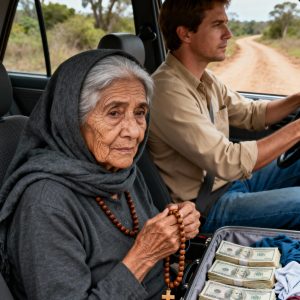It was meant to be nothing more than a quick bite between calls. Two patrol officers sat over half-eaten burgers when a confident little boy wandered up to their booth, lifted one untied sneaker, and asked, “Could you fix this for me?”
Officer Javier Ramírez laughed softly, lowered himself to the tiled floor, and laced the boy’s shoe with deliberate care while his partner, Officer Jenna Willis, watched, amused. The moment felt almost too ordinary to remember—until the door slammed open.
A breathless man burst inside, face drained of color. “Help! Someone just snatched a child at the gas station!” he shouted, gripping a chair for balance.
Ramírez shot upright, one hand already on his radio. Lunch break over. Instinct kicked in.
Outside, the officers sprinted across the lot to the adjacent gas station. A woman stood beside a silver SUV, sobbing, arms reaching for someone no longer there.
“My daughter! He took her!” she cried, pointing down the road.
Willis relayed details: white panel van, no side windows. Ramírez scanned for tire marks and pulled fragments of the woman’s story as sirens wailed in the distance.
Back inside the diner, the shoelace boy—Malik—stood frozen by the booth. Waitress Kyra knelt beside him. “You okay, kiddo?”
He glanced at the street. “That man… looked like my uncle. He drives a white van too. Mama says I can’t go with him anymore.”
Kyra’s pulse spiked. She hurried to the manager: “He might know something.”
Traffic cameras pinged: a white van had blown a red light three blocks away. Officers fanned out. Twenty tense minutes later, the van turned up behind an abandoned warehouse.
Inside, they found the missing girl—shaken but safe—clutching her pink bunny. The driver, a repeat offender with a dragon tattoo and a decayed front tooth, was caught sneaking out a back door.
When Willis and Ramírez returned to the diner with the rescued child, patrons erupted in relieved applause. Yet Ramírez’s attention snapped back to Malik.
“What’s your name, champ?”
“Malik.”
“Malik, tell me more about this ‘uncle.’”
Malik hesitated. “He used to get me from daycare. One time he just… kept driving. Mama was angry. She said we don’t see him anymore. He’s got that dragon on his arm—and a black tooth.”
Ramírez’s eyes widened. Same tattoo, same tooth. Dispatch confirmed: the abductor wasn’t Malik’s uncle at all—just a family “friend” who’d groomed trust for months.
Turns out the man had planned to grab Malik after school that very afternoon. Instead, Malik’s untied shoe led him into a diner full of cops—buying the precious minutes that exposed the kidnapper.
Child services kept Malik safe until his mother, frantic and tear-stained, arrived. She hugged him so tightly he wriggled for air.
News outlets ran the headline: “Quick-Thinking Officers, Brave Boy Foil Kidnapping”—but the real miracle was still unfolding. Evidence in the van linked the suspect to a small trafficking ring. An off-duty officer later spotted a similar van lurking near a school; arrests snowballed. Four would-be abductors, stopped before they struck.
At trial, the judge singled out Malik: “Courage sometimes sounds like a small voice asking for help.” His mother squeezed his hand the entire time.
Life eased back to normal. Malik learned to tie his own shoes, filled sketchbooks with superheroes, and received a picture book from Officer Ramírez titled Real Heroes Wear Badges, Not Capes.
Kyra launched a fundraiser named “Tied Together” to support kids coping with trauma—its logo a simple knotted lace. The diner framed a photo of Malik, the officers, and the rescued girl; it greets every customer by the register, a silent reminder that the biggest miracles can hide inside the tiniest pauses.
Takeaway
A pause for a shoelace. A child’s request. A chain of lifesaving events. Bravery isn’t always a dramatic showdown—it can be the simple act of trusting someone enough to say, “I need help.”





